MASSACHUSETTS BAY COLONY
Unit Overview
In the last unit, you learned about Jamestown Settlement and Plymouth Colony in North America. You also learned who the Pilgrims were and why they came to the New World. In this unit, you are going to learn about the Puritans and the Massachusetts Bay Colony. You will also learn about one of the worst events in Puritan history, the Salem Witch Trials. Finally, you will compare and contrast the Pilgrims and the Puritans.
Puritans
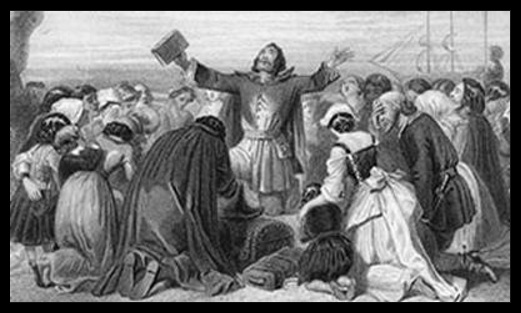
About 10 years after the Pilgrims landed at Plymouth Rock, a large group of people called the Puritans arrived in the New World, also from England. They believed everyone should belong to the Church of England, but they had left England because they believed the Church of England needed to be purified. In their opinion, the Church back in England was embracing too many Catholic beliefs. They were led by John Winthrop. When they arrived in the New World, they settled in what would become Boston and started the Massachusetts Bay Colony.
They were a big group. They were very stern and serious about their religion and beliefs. If anyone disagreed with them or questioned them, they believed that person was controlled by the devil.
Some of their important beliefs included:
- everything should be done in moderation.
- everyone should be able to read and understand the teachings of the Bible, not just priests.
- Sunday, the Sabbath, should only be spent reading the scriptures and thinking about God.
- human beings were sinners with no hope of entering Heaven, except for the Puritans, who were a people apart (and superior) from other people, and even then, a Puritan could only enter Heaven if they lived their entire life as God would wish.
- morally, the Puritans believed their role in life was to be a chosen people whose job for God was to create a New Jerusalem.
The Puritans believed in education and founded Harvard in 1636. It is the oldest university in the United States. Women played an important role in Puritan life. They ran the household, including the finances and education of the children. Unlike many women of the time, Puritan women were taught to read, although during town meetings only male church members were allowed to vote.
The Puritans played a major role in colonizing much of the United States, including the New England colonies of Massachusetts Bay, Rhode Island, and Connecticut. The Puritans were English Christians who did not agree with the practices of the Church of England. They were different from the Separatists (many of the Pilgrims were Separatists) in that they wanted to stay with the Church of England but change the practices from within the church. The Separatists, on the other hand, wanted to leave the Church of England and start their own church.
The Puritans wanted the reformed church to be very different from the Catholic church. Their church services were simple and were centered around the Bible. The church building itself was simple with few decorations. No musical instruments were allowed to be played inside the church. The Puritans were Christians who followed the philosophies of John Calvin and believed that faith, not works, was the key to salvation. Puritan worship services were very long.
The Puritans moved to America in order to practice their religion free from persecution. All English subjects were expected to be members of the Church of England. Being a Puritan was illegal and people who practiced Puritanism had a tough time in England. Things got especially difficult for Puritans in England around the 1620s and 1630s when the Catholic archbishop decided it was time to wipe out Puritanism in England.
Massachusetts Bay Colony
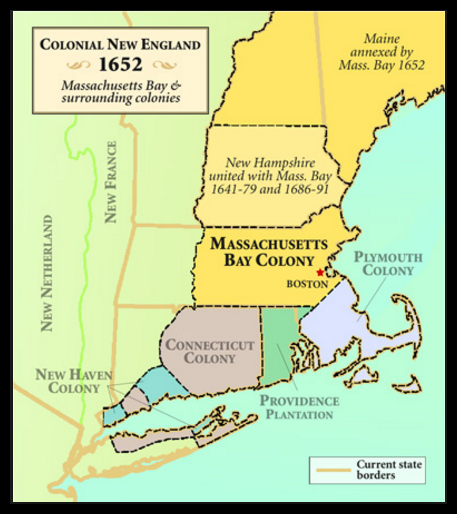
In 1630, eleven ships led by John Winthrop arrived in New England carrying more than 700 Puritan settlers. They established the Massachusetts Bay Colony and settled near the modern day city of Boston. John Winthrop served as governor of the new colony. He wanted it to be a "city on a hill" (a passage from the Bible) that would be an example to Europe of how a Protestant society could flourish. The next ten years is sometimes referred to as The Great Migration. During this time around 20,000 Puritans moved from England to New England. Many of these immigrants were families who continued to have children, allowing the colony to grow quickly in population.
The Puritan leaders of Massachusetts Bay Colony had very strict rules and regulations regarding their church. People who disagreed with them were often forced to leave the colony. Some of these people formed new colonies to the south of Massachusetts, including Rhode Island and Connecticut. A sermon could easily last two hours and a prayer could go on for over an hour. Residents of the colony who did not attend church were often fined or even put into the stocks as punishment.
Roger Williams was a Puritan religious leader who believed that the government should be separate from the church. He also thought that people should have more religious freedom. He was banished from Massachusetts and formed his own settlement called Providence in 1636. Another Puritan leader, Anne Hutchinson, spoke out against the Puritan leaders of Massachusetts. She said they were focusing on "works" for salvation and not "faith." She was banished as well and started the settlement of Portsmouth in 1638. Portsmouth and Providence, along with two other settlements, merged together to form the English Colony of Rhode Island and Providence Plantations in 1644.
Another prominent Puritan leader in Massachusetts, Thomas Hooker, formed the Colony of Connecticut in 1636 after a disagreement over who should have the right to vote. Connecticut became the first colony to have its own written constitution that created a formal government.
One of the worst events in Puritan history was the Salem Witch Trials where 20 people were executed for witchcraft.
Salem Witch Trials
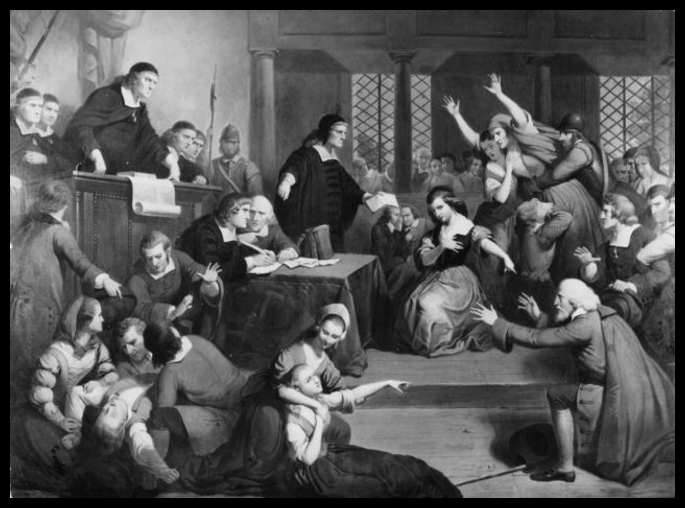
During the late 17th century, the Puritans of New England believed that witchcraft was the work of the devil and was very real. This fear was not new to the United States. Throughout the late Middle Ages and into the 1600s, thousands of people were executed in Europe for being witches.
In the summer of 1692, nineteen men and women were hung after having been convicted of witchcraft. The hysteria began the previous winter and was over by early autumn of 1692. To pass the cold winter days of 1692, several girls began meeting at Rev. Parris’ home. Tituba, the Parris’ slave from Barbados, entertained the girls with her stories of witchcraft and demons. Tituba also told the girls’ fortunes. Soon, Rev. Parris’ daughter, Betty (age 9), and her cousin, Abigail Williams (age 11), became frightened by the stories and fortunes, and they began to act strangely. They had terrible fits, darting around the house, screaming and crying and writhing as if they were in pain. They claimed they felt as if they were being pinched and stuck with pins. When they interrupted church, the people in Salem knew the devil was at work.
Rev. Parris called Salem Village’s doctor, Willam Griggs because he thought the girls’ behavior might be an illness. The doctor failed to find any medical cause for their fits, so he concluded that the girls must be bewitched. During that time period, most people believed one could make an agreement with the devil in exchange for evil powers. This was considered a great sin, and the girls didn’t speak out immediately. At the end of February, the girls blamed their condition on witchcraft. They said that three women in the village had cast spells on them: Tituba, the girls' servant who told them stories of witchcraft and probably gave them the idea; Sarah Good, a local beggar and homeless person; and Sarah Osborne, an old lady who rarely came to church. Other girls in the village, including Ann Putnam, Elizabeth Hubbard, Susannah Sheldon, and Mary Warren, began to have similar fits, and they joined in the accusations. Soon, many villagers were arrested and jailed on charges of witchcraft.
Trials for the accused began in March. In order to receive a lesser sentence, some of the accused confessed their guilt and also spoke out against others. Because there were so many accused witches in jail, the governor set up a new court, the “court of oyer and terminer," specifically for the witchcraft cases. In the cases against the accused, “spectral evidence” (testimony that one was afflicted by someone’s specter, or ghost) was admitted, as were hearsay, gossip, and assumptions. The testimony of the girls was given great weight. If an accused person began to deny charges of witchcraft, the girls would immediately go into fits, claiming that the suspect was harming them.
There were a number of tests used to determine if a person was a witch:
- Touch test - The person afflicted with fits would become calm when touching the witch who cast the spell on them.
- Confession by Dunking - They would dunk an accused witch in water until they finally confessed.
- Lord's Prayer - If a person could not recite the Lord's Prayer without error, they were considered a witch.
- Spectral evidence - The accused would claim to have seen the witch in their dreams working with the devil.
- Submersion - In this test the accused was bound and dropped in the water. If they floated, they were considered a witch. Of course, if they didn't float, they would drown.
- Pressing - In this test, heavy stones would be placed on the accused. This was supposed to force the confession out of the witch. Unfortunately, the person being pressed couldn't breathe to give a confession even if they wanted to. An 80 year-old man named Giles Corey was crushed to death when this test was used on him.
The accused were made up of people from all walks of life; some were rich, some were poor, some were well-respected by the community (one was even a former minister), and some were publicly shunned. Overall, nineteen men and women were hung as a result of their trials, one man was pressed to death under heavy stones for refusing to stand trial, four people died in prison, one to two hundred others were jailed, and two dogs were executed as suspected accomplices to the witches. As more and more people were being accused, the public began to realize that innocent people were being condemned to death. After months of trials, the governor finally decided to put an end to the trials with the last trials being held in May of 1693. The governor pardoned the rest of the accused witches and they were released from jail.
Pilgrims vs. Puritans
Puritans and Pilgrims are two groups of people that originated from England and its church, the Anglican Church. Both groups are part of Puritanism, an activist movement after the English Reformation.
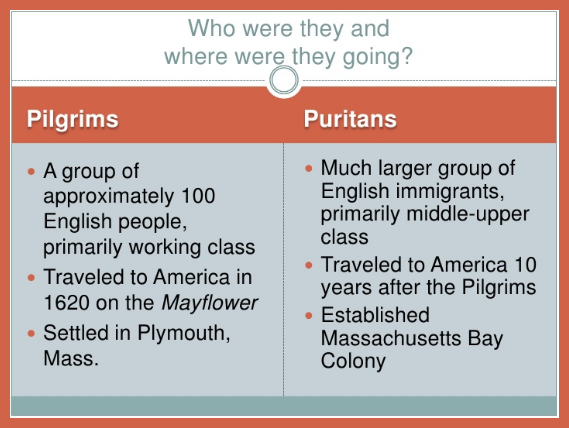

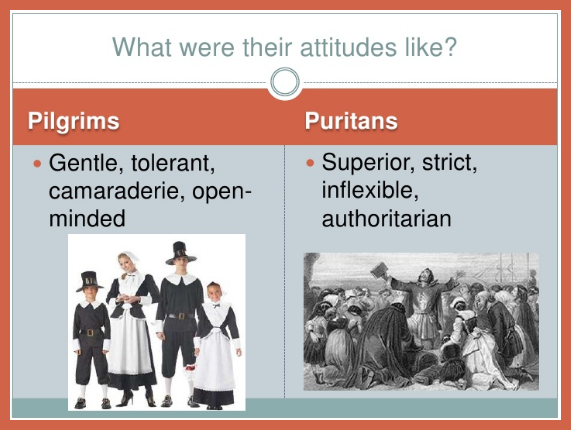

 |
| Unit 16 Pilgrims Article and Quiz |
| Unit 16 Colonial Leaders Article and Quiz |
Now answer the questions!